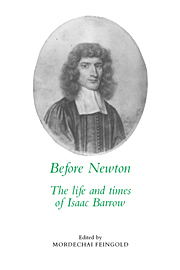Book contents
- Frontmatter
- Contents
- List of contributors
- Editor's preface
- 1 Isaac Barrow: divine, scholar, mathematician
- 2 The Optical Lectures and the foundations of the theory of optical imagery
- 3 Barrow's mathematics: between ancients and moderns
- 4 Isaac Barrow's academic milieu: Interregnum and Restoration Cambridge
- 5 Barrow as a scholar
- 6 The preacher
- 7 Isaac Barrow's library
- Index
Editor's preface
Published online by Cambridge University Press: 05 November 2011
- Frontmatter
- Contents
- List of contributors
- Editor's preface
- 1 Isaac Barrow: divine, scholar, mathematician
- 2 The Optical Lectures and the foundations of the theory of optical imagery
- 3 Barrow's mathematics: between ancients and moderns
- 4 Isaac Barrow's academic milieu: Interregnum and Restoration Cambridge
- 5 Barrow as a scholar
- 6 The preacher
- 7 Isaac Barrow's library
- Index
Summary
Our appraisal of historical scientific figures tends to be synonymous with their purported legacy to posterity – as adjudged by subsequent scholars; we rarely attempt to take into account their reputation among contemporaries or gauge their accomplishments within the context of their age. Obviously, a critical approach that equates historical “worth” with an appreciable contribution to future generations will – and must – be the primary focus of historians of science. Nonetheless, to use such a yardstick exclusively is to disregard the complexity of past events and to hamper seriously our ability to comprehend the precise character of the scientific enterprise; for all discoveries and breakthroughs in science, irrespective of the unique contribution of the individual who inaugurated them, cannot be considered in isolation, independent of a large community of teachers, fellow students, and scholars of the second order. The fact that the input of such persons is vague and amorphous, and cannot be assigned a simple letter in an equation, does not negate their contribution – it only makes more difficult our task of definition. And by failing to recognize this connectedness between individual genius and larger community, we not only distort the complexity and singularity of a historical moment, but also risk misconstruing the nature and magnitude of the innovation itself.
Isaac Barrow is a case in point. Esteemed by contemporaries as a profound mathematician as much as later generations esteemed him as a divine, his work had already, by the time of his death in 1677, been superseded by the discoveries of Newton and Leibniz.
- Type
- Chapter
- Information
- Before NewtonThe Life and Times of Isaac Barrow, pp. ix - xiiPublisher: Cambridge University PressPrint publication year: 1990



